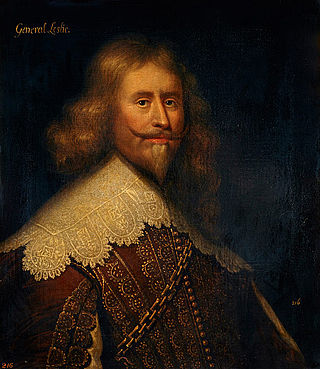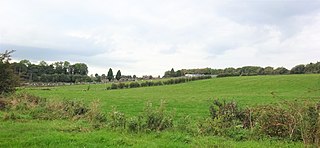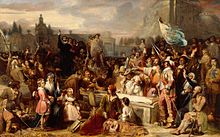
The Battle of Newburn, also known as the Battle of Newburn Ford, took place on 28 August 1640, during the Second Bishops' War. It was fought at Newburn, just outside Newcastle, where a ford crossed the River Tyne. A Scottish Covenanter army of 20,000 under Alexander Leslie defeated an English force of 5,000, led by Lord Conway.

Alexander Leslie, 1st Earl of Leven was a Scottish military officer and peer. Born illegitimate and raised as a foster child, he subsequently advanced to the rank of field marshal in Swedish Army, and in Scotland became Lord General in command of the Army of the Covenanters, a privy councillor, captain of Edinburgh Castle, Lord Balgonie and Earl of Leven. In England he commanded the Army of the Solemn League and Covenant and was senior commander of the Army of Both Kingdoms (1642–1647). Leslie served in the Thirty Years' War, the Bishops' Wars, and most of the English Civil War, fighting primarily in the First English Civil War. Leslie would live a long life, dying roughly at the age of 80 or 81.

The Wars of the Three Kingdoms were a series of conflicts fought between 1639 and 1653 in the kingdoms of England, Scotland and Ireland, then separate entities in a personal union under Charles I. They include the 1639 to 1640 Bishops' Wars, the First and Second English Civil Wars, the Irish Confederate Wars, the Cromwellian conquest of Ireland and the Anglo-Scottish War of 1650–1652. They resulted in the execution of Charles I, the abolition of monarchy, and founding of the Commonwealth of England, a unitary state which controlled the British Isles until the Stuart Restoration in 1660.

The Battle of Dunbar was fought between the English New Model Army, under Oliver Cromwell, and a Scottish army commanded by David Leslie on 3 September 1650 near Dunbar, Scotland. The battle resulted in a decisive victory for the English. It was the first major battle of the 1650 invasion of Scotland, which was triggered by Scotland's acceptance of Charles II as king of Britain after the beheading of his father, Charles I on 30 January 1649.

The Second English Civil War took place between February and August 1648 in England and Wales. It forms part of the series of conflicts known collectively as the 1639–1653 Wars of the Three Kingdoms, which include the 1641–1653 Irish Confederate Wars, the 1639–1640 Bishops' Wars, and the 1649–1653 Cromwellian conquest of Ireland.

The Anglo-Scottish war (1650–1652), also known as the Third Civil War, was the final conflict in the Wars of the Three Kingdoms, a series of armed conflicts and political machinations between shifting alliances of religious and political factions in England, Scotland and Ireland.

The Irish Rebellion of 1641 was an uprising in Ireland, initiated on 23 October 1641 by Catholic gentry and military officers. Their demands included an end to anti-Catholic discrimination, greater Irish self-governance, and return of confiscated Catholic lands. Planned as a swift coup d'état to gain control of the Protestant-dominated central government, instead it led to the 1641–1653 Irish Confederate Wars, part of the wider Wars of the Three Kingdoms.

Between 1639 and 1652, Scotland was involved in the Wars of the Three Kingdoms, a series of conflicts which included the Bishops' Wars, the Irish Rebellion of 1641, the English Civil War, the Irish Confederate Wars and finally the conquest of Ireland and the subjugation of Scotland by the English New Model Army.

The Engagers were a faction of the Scottish Covenanters, who made "The Engagement" with King Charles I in December 1647 while he was imprisoned in Carisbrooke Castle by the English Parliamentarians after his defeat in the First Civil War.

The Battle of Inverkeithing was fought on 20 July 1651 between an English army under John Lambert and a Scottish army led by James Holborne as part of an English invasion of Scotland. The battle was fought near the isthmus of the Ferry Peninsula, to the south of Inverkeithing, after which it is named.

Randall MacDonnell, 1st Marquess of Antrim (1609–1683) was a Roman Catholic landed magnate in Scotland and Ireland, son of the 1st Earl of Antrim. He was also chief of Clan MacDonnell of Antrim. He is best known for his involvement, mostly on the Royalist side, in the Wars of the Three Kingdoms.
The Battle of Hieton was fought on the 1 December 1650 between a force of Scottish Remonstrants under Colonel Gilbert Ker and 1,000 English commanded by Major-general John Lambert. The site of the battle was by the Cadzow Burn, near the present day town centre of Hamilton, Scotland. The Scots attacked, surprising the English, but were beaten back and destroyed as a fighting force. The battle was part of the Anglo-Scottish war of 1650–1652.
The Treaty of Berwick was an agreement between the Kingdom of England and the Kingdom of Scotland, signed on 18 June 1639, which ended the First Bishops' War.

The Bishops' Wars were two separate conflicts fought in 1639 and 1640 between Scotland and England, with Scottish Royalists allied to England. They were the first of the Wars of the Three Kingdoms, which also include the First and Second English Civil Wars, the Irish Confederate Wars, and the 1650 to 1652 Anglo-Scottish War.

The Battle of Preston, fought largely at Walton-le-Dale near Preston in Lancashire, resulted in a victory for the New Model Army under the command of Oliver Cromwell over the Royalists and Scots Engagers commanded by the Duke of Hamilton. The Parliamentarian victory presaged the end of the Second English Civil War.

The Battle of Mauchline Muir was an engagement fought on 12 June 1648 between two rival factions of the Covenanters of Scotland. On one side were those who favoured The Engagement, known as Engagers, and on the other those who were opposed to the Engagement, and known as the Kirk party.
This is a timeline of events leading up to, culminating in, and resulting from the Wars of the Three Kingdoms.

The siege of Dundee, 23 August to 1 September 1651, took place during the 1650 to 1652 Anglo-Scottish war. After a two-day artillery bombardment, a Covenanter garrison under Robert Lumsden surrendered to Commonwealth of England forces commanded by George Monck.

The Battle of the Brig of Dee took place on 18–19 June 1639 at the Bridge of Dee in Scotland, and was the only serious military action of the First Bishops' War. It featured a Royalist force under James Gordon, 2nd Viscount Aboyne, opposed by Covenanters led by James Graham, 5th Earl of Montrose, and resulted in a Covenanter victory.
The following outline is provided as an overview of and topical guide to the wars of the Three Kingdoms:



















